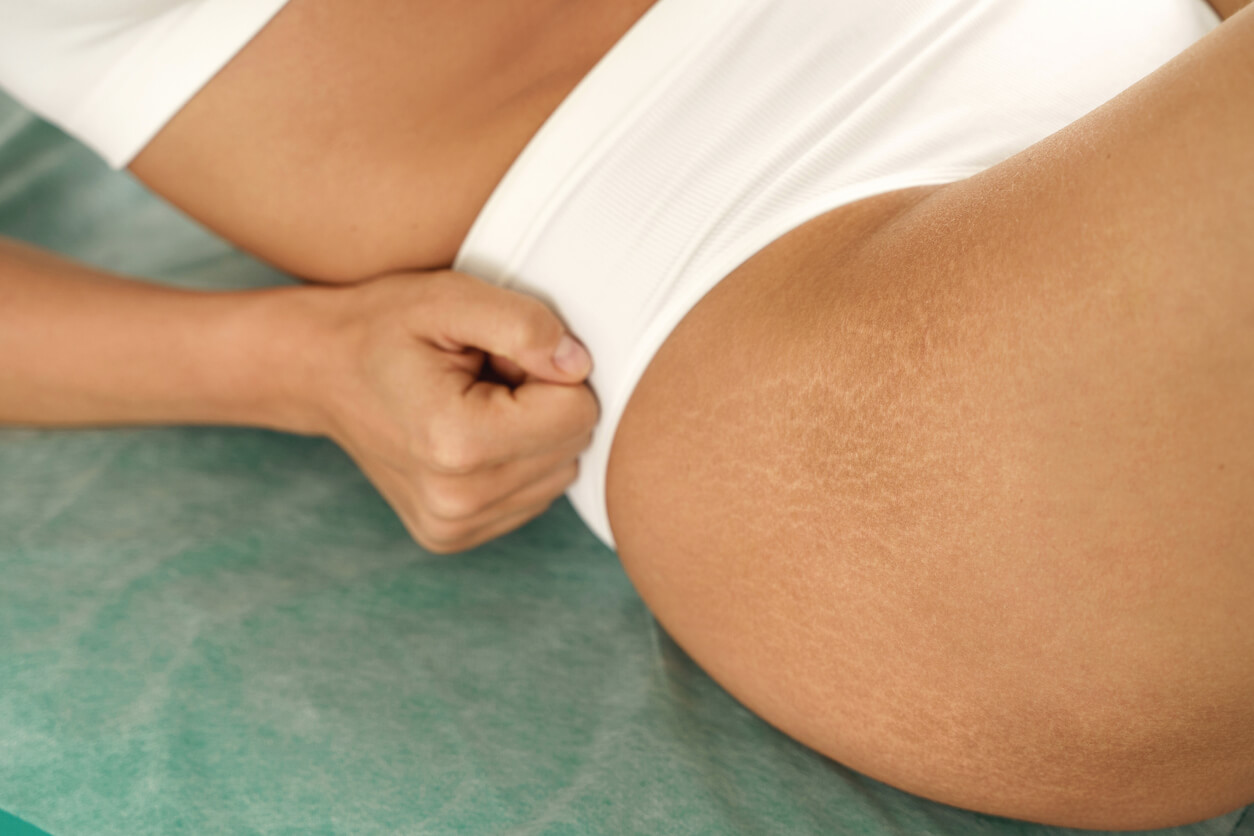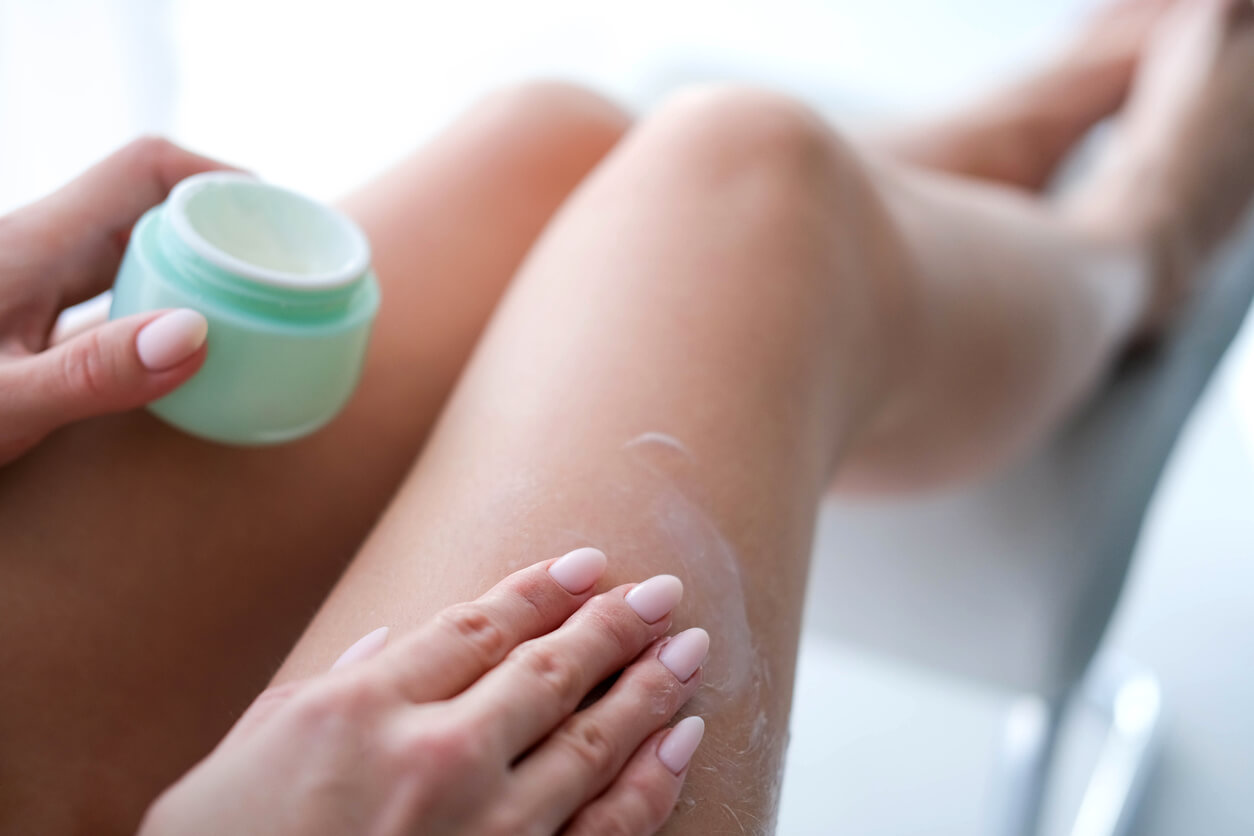How to Reduce Stretch Marks with Aloe Vera?


Written and verified by the dermatologist Maria del Carmen Hernandez
Can you reduce stretch marks with the use of aloe vera? Although they don’t present symptoms, they’re usually one of the most unwanted and annoying skin manifestations.
For this reason, the beneficial properties of aloe vera can contribute to preventing or diminishing their appearance.
What are stretch marks?
Stretch marks are scars that are generated by changes in the tension of the skin surface due to alterations in body volume. As a result, the elastic fibers break and leave linear marks on the skin. They can appear anywhere on the body, but are most prevalent on the hips, breasts, abdomen, or arms.
Furthermore, they’re not only caused by changes in body weight, but also by the following factors:
- Poor nutrition
- Stress
- Underlying diseases
- Genetic factors
Types of stretch marks
According to a recent publication, stretch marks in their acute stage, which are of pink or purplish coloration, have the ability to disappear through early treatment or evolve into white stretch marks.
It’s best to begin to reduce stretch marks with aloe vera in the acute stage of their development, as this doesn’t require very invasive treatments.
On the contrary, white stretch marks are atrophic, hypopigmented, and wrinkled scars that evolved over time. Therefore, their management and eradication treatment are more complex and the application of also vera isn’t usually effective.

What is aloe vera?
Aloe vera, which is marketed as a gel, comes from a plant that has many different species. While it’s possible to use the leaves of the plant, it’s better to use a topical gel, which is quite similar.
In addition, it’s much easier to use a gel that’s ready to apply and may even contain other beneficial ingredients.
Aloe vera properties
When aloe vera’s used correctly, it can contribute to reducing a wide variety of ailments. In fact, it provides the necessary moisture for the skin to carry out its physiological processes, including healing and regeneration.
In addition, it has the ability to improve collagen production, favored by its antioxidant vitamin E and C content. In turn, its antibacterial properties allow it to be effective in the treatment of wounds and minor cuts.
One of the qualities of aloe vera that stands out the most is its important cell regeneration capacity. That is, it allows for the restoration of skin tissues by increasing the body’s natural elastin and collagen.
Specifically, the effects that aloe vera possesses include the following:
- Regeneration: Aloe vera contains gibberellins and auxins that stimulate the natural production of collagen and, consequently, the prevention of stretch marks.
- Repair: Aloe vera has the ability to repair tissues through its antioxidant components.
- Moisturization: The large amount of water, minerals, and vitamins it contains allows the hydration of the deepest layers of the skin. At the same time, it contributes to the retention of moisture in the skin.
- Rejuvenation: The aloe plant provides protection against free radicals and keeps skin tissues more elastic and firm.
The prevention of stretch marks
Preventing the development of stretch marks requires several factors and measures to be taken into account and put into practice. We’ll tell you about them below.
Proper nutrition
In order to prevent and reduce stretch marks, it’s vital to consume a healthy, correct, and balanced diet. It’s important to keep the body at an ideal weight and provide it with the necessary nutrients to synthesize all the substances required by its physiology.
A diet that promotes the production of collagen can also be useful. For this, foods with a high content of lipoic acid, taurine, vitamin A and vitamin C should be prioritized.
You may be interested in Skin Exfoliation During Pregnancy: Everything You Need to Know

Constant moisturizing of stretch marks with aloe vera
The skin must be kept hydrated to prevent the appearance of stretch marks, cracks, or unwanted and annoying marks. Therefore, the use of aloe vera in your care routine is important.
Experts recommend applying aloe vera after showering and prioritizing the areas of stretch marks. Also, the application should involve massage and circular movements, as its absorption is quite fast.
Moisturizing the body
Not only must the skin be moisturized from the outside, but also the internal hydration of the body is important. In other words, you should drink at least 2 liters of water every day in order to maintain the proper functioning of the body.
According to the American Osteopathic College of Dermatology, one of the pillars of stretch mark prevention is proper hydration. In addition, ingesting excess water isn’t harmful to health, as it’ll be eliminated through urine.
Aloe vera in the skincare routine to reduce stretch marks
In conclusion, adding the use of aloe vera in your skincare routine is an excellent option to prevent and reduce stretch marks. However, whenever you have doubts about its use, you can always consult with the appropriate professional.
Can you reduce stretch marks with the use of aloe vera? Although they don’t present symptoms, they’re usually one of the most unwanted and annoying skin manifestations.
For this reason, the beneficial properties of aloe vera can contribute to preventing or diminishing their appearance.
What are stretch marks?
Stretch marks are scars that are generated by changes in the tension of the skin surface due to alterations in body volume. As a result, the elastic fibers break and leave linear marks on the skin. They can appear anywhere on the body, but are most prevalent on the hips, breasts, abdomen, or arms.
Furthermore, they’re not only caused by changes in body weight, but also by the following factors:
- Poor nutrition
- Stress
- Underlying diseases
- Genetic factors
Types of stretch marks
According to a recent publication, stretch marks in their acute stage, which are of pink or purplish coloration, have the ability to disappear through early treatment or evolve into white stretch marks.
It’s best to begin to reduce stretch marks with aloe vera in the acute stage of their development, as this doesn’t require very invasive treatments.
On the contrary, white stretch marks are atrophic, hypopigmented, and wrinkled scars that evolved over time. Therefore, their management and eradication treatment are more complex and the application of also vera isn’t usually effective.

What is aloe vera?
Aloe vera, which is marketed as a gel, comes from a plant that has many different species. While it’s possible to use the leaves of the plant, it’s better to use a topical gel, which is quite similar.
In addition, it’s much easier to use a gel that’s ready to apply and may even contain other beneficial ingredients.
Aloe vera properties
When aloe vera’s used correctly, it can contribute to reducing a wide variety of ailments. In fact, it provides the necessary moisture for the skin to carry out its physiological processes, including healing and regeneration.
In addition, it has the ability to improve collagen production, favored by its antioxidant vitamin E and C content. In turn, its antibacterial properties allow it to be effective in the treatment of wounds and minor cuts.
One of the qualities of aloe vera that stands out the most is its important cell regeneration capacity. That is, it allows for the restoration of skin tissues by increasing the body’s natural elastin and collagen.
Specifically, the effects that aloe vera possesses include the following:
- Regeneration: Aloe vera contains gibberellins and auxins that stimulate the natural production of collagen and, consequently, the prevention of stretch marks.
- Repair: Aloe vera has the ability to repair tissues through its antioxidant components.
- Moisturization: The large amount of water, minerals, and vitamins it contains allows the hydration of the deepest layers of the skin. At the same time, it contributes to the retention of moisture in the skin.
- Rejuvenation: The aloe plant provides protection against free radicals and keeps skin tissues more elastic and firm.
The prevention of stretch marks
Preventing the development of stretch marks requires several factors and measures to be taken into account and put into practice. We’ll tell you about them below.
Proper nutrition
In order to prevent and reduce stretch marks, it’s vital to consume a healthy, correct, and balanced diet. It’s important to keep the body at an ideal weight and provide it with the necessary nutrients to synthesize all the substances required by its physiology.
A diet that promotes the production of collagen can also be useful. For this, foods with a high content of lipoic acid, taurine, vitamin A and vitamin C should be prioritized.
You may be interested in Skin Exfoliation During Pregnancy: Everything You Need to Know

Constant moisturizing of stretch marks with aloe vera
The skin must be kept hydrated to prevent the appearance of stretch marks, cracks, or unwanted and annoying marks. Therefore, the use of aloe vera in your care routine is important.
Experts recommend applying aloe vera after showering and prioritizing the areas of stretch marks. Also, the application should involve massage and circular movements, as its absorption is quite fast.
Moisturizing the body
Not only must the skin be moisturized from the outside, but also the internal hydration of the body is important. In other words, you should drink at least 2 liters of water every day in order to maintain the proper functioning of the body.
According to the American Osteopathic College of Dermatology, one of the pillars of stretch mark prevention is proper hydration. In addition, ingesting excess water isn’t harmful to health, as it’ll be eliminated through urine.
Aloe vera in the skincare routine to reduce stretch marks
In conclusion, adding the use of aloe vera in your skincare routine is an excellent option to prevent and reduce stretch marks. However, whenever you have doubts about its use, you can always consult with the appropriate professional.
All cited sources were thoroughly reviewed by our team to ensure their quality, reliability, currency, and validity. The bibliography of this article was considered reliable and of academic or scientific accuracy.
- Hajhashemi M, Rafieian M, Rouhi Boroujeni HA, Miraj S, Memarian S, Keivani A, Haghollahi F. The effect of Aloe vera gel and sweet almond oil on striae gravidarum in nulliparous women. J Matern Fetal Neonatal Med. 2018 Jul;31(13):1703-1708. doi: 10.1080/14767058.2017.1325865. Epub 2017 May 19. PMID: 28521546.
- Striae. [Internet]. Disponible en: https://www.aocd.org/page/Striae
- Oakley AM, Patel BC. Stretch Marks. [Updated 2021 Aug 11]. In: StatPearls [Internet]. Treasure Island (FL): StatPearls Publishing; 2021 Jan-. Available from: https://www.ncbi.nlm.nih.gov/books/NBK436005/
This text is provided for informational purposes only and does not replace consultation with a professional. If in doubt, consult your specialist.








